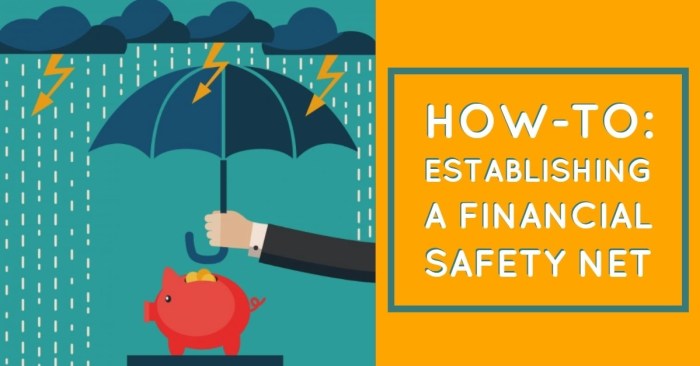Get ready to dive into the world of financial security as we explore the ins and outs of building a financial safety net. From emergency funds to insurance coverage, we’ve got you covered with all you need to know to protect your finances from unforeseen challenges. So buckle up and let’s get started on this money-saving journey!
Importance of a Financial Safety Net
Having a financial safety net is crucial for ensuring stability and peace of mind in times of uncertainty. It acts as a cushion to protect you from unexpected financial hardships and emergencies, allowing you to maintain your financial well-being even when faced with challenges.
Key Benefits of Having a Financial Safety Net
- Protection during emergencies: A financial safety net can help cover unexpected expenses such as medical bills, car repairs, or job loss, preventing you from going into debt.
- Reduced stress and worry: Knowing that you have a safety net in place can alleviate anxiety about financial insecurity, allowing you to focus on other aspects of your life.
- Opportunity for investment and growth: With a safety net, you can take calculated risks, pursue new opportunities, or invest in your future without the fear of financial ruin.
Examples of Financial Safety Net in Action
Imagine losing your job unexpectedly, but having enough savings to cover your expenses for several months while you search for a new job. This financial safety net provides peace of mind and allows you to focus on finding the right opportunity without the added stress of financial strain.
Another example is having an emergency fund to cover unexpected medical expenses or home repairs, ensuring that you can address these issues promptly without worrying about how to afford them.
Building an Emergency Fund

Building an emergency fund is crucial for financial stability and peace of mind. It serves as a safety net during unexpected situations like job loss, medical emergencies, or car repairs. Here’s how you can start building your emergency fund:
Recommended Amount to Save
Financial experts recommend saving at least 3 to 6 months’ worth of living expenses in your emergency fund.
- Create a budget to determine your monthly expenses.
- Set a specific savings goal based on your expenses and income.
- Start small by saving a percentage of your income each month.
- Automate your savings by setting up automatic transfers to your emergency fund account.
Types of Expenses to Cover
An emergency fund should cover essential expenses that are necessary for your daily living. These may include:
- Housing costs (rent or mortgage payments)
- Utilities (electricity, water, heating)
- Food and groceries
- Transportation (car repairs, public transportation)
- Healthcare expenses (medical bills, insurance deductibles)
- Debt payments (credit card bills, loans)
Insurance Coverage
Insurance plays a vital role in building a financial safety net by providing protection against unexpected events that could lead to significant financial burdens. It serves as a safeguard to help individuals and families mitigate risks and recover from unforeseen circumstances.
Types of Insurance Policies
- Health Insurance: Covers medical expenses in case of illness or injury.
- Auto Insurance: Offers protection in the event of car accidents or theft.
- Homeowners/Renters Insurance: Provides coverage for damage or loss of property due to disasters or theft.
- Life Insurance: Ensures financial security for loved ones in the event of the policyholder’s death.
- Disability Insurance: Offers income replacement if the policyholder becomes unable to work due to a disability.
Protection Against Financial Burdens
Insurance can shield individuals from the financial repercussions of unexpected events. For example, health insurance can help cover costly medical treatments, while auto insurance can assist with repair expenses after an accident. Having the right insurance coverage in place can prevent individuals from facing overwhelming financial challenges during difficult times.
Diversifying Income Sources
Diversifying income sources is crucial for achieving financial stability and building a strong safety net. Relying on a single source of income can leave you vulnerable to unexpected financial crises, such as job loss or economic downturns. By diversifying your income streams, you can create a more resilient financial foundation that can withstand unforeseen challenges.
Strategies for Diversifying Income Streams
- Start a side hustle or freelance work in your spare time to generate additional income.
- Invest in stocks, bonds, real estate, or other assets that can provide passive income streams.
- Monetize your hobbies or skills by offering online courses, consulting services, or selling handmade products.
- Create multiple streams of passive income through affiliate marketing, rental properties, or royalties from creative work.
Benefits of Multiple Income Sources
- Diversification reduces the risk of income loss in case one source dries up, providing a safety net during tough times.
- Additional income streams can accelerate wealth-building and help you achieve financial goals faster.
- Having diverse sources of income can increase your financial independence and flexibility, giving you more control over your financial future.
